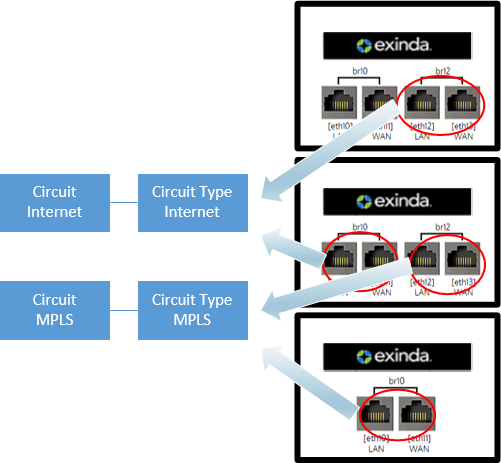Circuit types in the EMC
Circuit Types are used to identify the purpose of the circuit and the appliance bridges. When the purpose of the circuit and an appliance bridge align, then the circuit is bound to that bridge in the configuration that is sent to the appliances. Note that Circuit Types do not exist on appliances. Circuit Types abstract the binding between the circuits and the appliance bridges. Therefore, the appliances can be treated similarly even when they do not have the same number of bridges and when they are not connected in the same way.
Circuit Types are defined in the Configuration Library and are used by circuits and appliance bridge-to-circuit type mappings.
The following example will further clarify the concept of circuit types:

Circuit types example
Consider the following in the example above:
- Bridge br12 from first appliance and bridge br10 on second appliance are both bound to circuit type "Internet". Since, this circuit type 'Internet' is tied to the circuit "Internet", all the policies within the 'Internet' circuit are applied to bridge br12 on the first appliance and br10 on the second appliance.
- Bridge br12 on the second appliance and bridge br10 on third appliance are bound to circuit type "MPLS". Since, this circuit type 'MPLS' is tied to the circuit "MPLS", all the policies within the 'MPLS' circuit are applied to bridge br12 on the second appliance and br10 on the third appliance.
The Circuit Type librarythe Exinda repository for network objects and their definitions items can be found in Library > Circuit Types.
To assign the Circuit Type to a circuit, see Circuits.
To assign Circuit Types to appliance bridges, see Bridge/Circuit Type Mapping.